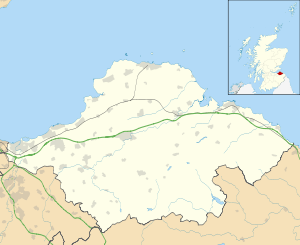Dunglass
| Dunglass | |
 Dunglass Bridge and Viaduct above Dunglass Burn |
|
 Dunglass |
|
| OS grid reference | NT765721 |
|---|---|
| Civil parish | Oldhamstocks |
| Council area | East Lothian |
| Lieutenancy area | East Lothian |
| Country | Scotland |
| Sovereign state | United Kingdom |
| Post town | COCKBURNSPATH |
| Postcode district | TD13 |
| Dialling code | 01368 |
| Police | Scottish |
| Fire | Scottish |
| Ambulance | Scottish |
| EU Parliament | Scotland |
| UK Parliament | East Lothian |
| Scottish Parliament | East Lothian |
Coordinates: 55°56′31″N 2°22′34″W / 55.942°N 2.376°W
Dunglass is a hamlet in East Lothian, Scotland, lying east of the Lammermuir Hills on the North Sea coast. It has a 15th-century Dunglass Collegiate Church, now in the care of Historic Scotland. Dunglass is the birthplace of Sir James Hall, an 18th-century Scottish geologist and geophysicist.
Geography
Dunglass is a small settlement located about 1 km (0.5 mi) northwest of Cockburnspath and 11 km (7 mi) southeast of Dunbar. The whole of Dunglass lies in an area of 2.47 km², located within the historical county of Haddingtonshire and the parish of Oldhamstocks. It lies to the east of the Lammermuir Hills on the North Sea coast at the point where the old Great North Road and modern A1 as well as the London-Edinburgh railway cross the gorge of the Dunglass Burn. The burn is the historical boundary between the counties of Haddingtonshire or East Lothian and Berwickshire. From 1975-96 it was the boundary between Lothian and Borders Regions. It is now the boundary between the council areas of East Lothian and the Scottish Borders. Other settlements nearby include Cove, Pease Bay, and Pease Dean.
Dunglass Castle and estate
Dunglass Castle, once a stronghold of the Earls of Home, was built in the 14th century. It passed, on their forfeiture in 1516, to the Douglas Earl of Angus, but was besieged and destroyed by the English under the Henry Percy, 6th Earl of Northumberland in the winter of 1532, and again under the Protector Somerset in 1547, when held by Sir George Douglas.[1][2]
The castle was rebuilt, in an enlarged and improved form, and gave accommodation in 1603 to James VI of Scotland, and all his retinue, when on his journey to London to take up the English throne.[2]
However, it was again destroyed in 30 August 1640 when held by a party of Covenanters under Thomas Hamilton, 2nd Earl of Haddington. An English page, according to Scotstarvet, vexed by a taunt against his countrymen, thrust a red-hot iron into a powder barrel, and himself was killed, with the Earl, his half-brother, Richard, and many others.[2]
The Hall family occupied Dunglass for 232 years from 1687. Francis James Usher bought the Estate from Sir John Richard Hall, 9th Bart in 1919, and the estate remains in the Usher family.[3]
Sir James Hall
In the Spring of 1788, the geologist Sir James Hall together with John Playfair and James Hutton set off from Dunglass Burn in a boat heading east along the coast looking for evidence to support Hutton's theory that rock formations were laid down in an unending cycle over immense periods of time. They found examples of Hutton's Unconformity at several places, particularly an outcrop at Siccar Point sketched by Sir James Hall. As Playfair later recalled, "The mind seemed to grow giddy by looking so far back into the abyss of time".[4]
See also
- Dunglass Collegiate Church, dates to 1443
- Chapel of St. Mary at Dunglass, dates to 1423
- Dunglass Viaduct
- Dunglass railway bridge
- Earl of Home
Notes
- ↑ The Pictorial History of England, vol. 2, by George Lillie Craik, Charles MacFarlane
- ↑ 2.0 2.1 2.2 Ordnance Gazetteer of Scotland, by Francis Groome
- ↑ http://www.dunglassestate.com
- ↑ Hutton’s Journeys to Prove his Theory, JamesHutton.org
External links
| Wikimedia Commons has media related to Dunglass. |